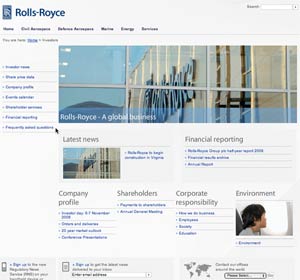This week I visited Rolls-Royce’s investor site and found much to like. Similar to a well-engineered engine, the site seemed to do exactly what it was supposed to with a minimum of fuss or wasted energy.
To start, the tab for investors is the second tab listed on the top banner on the Roll-Royce home page. No hunting involved here, as you would be hard pressed to miss the link. The main investor page is well laid out, with the main links listed down the left hand side of the page, plenty of white space and a generally pleasing color palette, although there appears to be three or four different shades of blue printing employed, which is about two more than I would prefer. Otherwise, things are where you can find them and digging into the tabs leads you to good information. For example, the Share Price Data tab gives you an option to create your own share price chart with custom dates and comparisons to the FTSE All Share and FTSE Aero Defence indexes.
But then I dug just a little deeper, and of course, I found something that just didn’t sound right. Knowing that Rolls-Royce has been through many changes over the years, I wanted to see how they described themselves and their businesses, so I went to the Company Profile page. Here’s their introductory sentence in the section titled “Company overview”: “Rolls-Royce, is a global business, providing and supplying integrated power systems for use on land, at sea and in the air.” This is a sentence that reads as if it was lifted from a corporate mission statement written by a consultant. It begs to be explained, but of course, it isn’t. What do they mean by integrated power systems? I think Rolls-Royce is trying to say that they do more than make engines, but they are saying it in such a vague manner as to obscure the issue even more. Considering that the large majority of Rolls-Royce’s sales and profits come from their businesses of making civilian and defence aircraft engines, you would think that they would want to expressly acknowledge this fact. Instead, eager to position itself in the greater power systems global market, we have the use of the phrase “integrated power systems”. This can mean anything from alternative energy to electrical transmission grids. This is fuzzy writing.
I am comforted by the fact that their engineering appears to be better than their writing.
John recently retired as a Lecturer in Management at Rice University’s Jones Graduate School of Management, where he taught investor relations. Prior to that, John was in charge of investor relations for Sysco Corporation and Walgreen Co. He holds a MBA from the Kellogg Graduate School of Management at Northwestern University and a law degree from Loyola University of Chicago.
You can learn more about John’s thinking about investor relations at his blog, Investor Relations Musings.

“Integrated” has to be one of the most over-used corporate words after “solutions”. (Actually, more often than not, solutions are themselves described as integrated).
I have long hated the nasty word “integrated” – it’s clunky, Latinate and meaningless to most ordinary people. Well done, you, for picking up on this particular use!